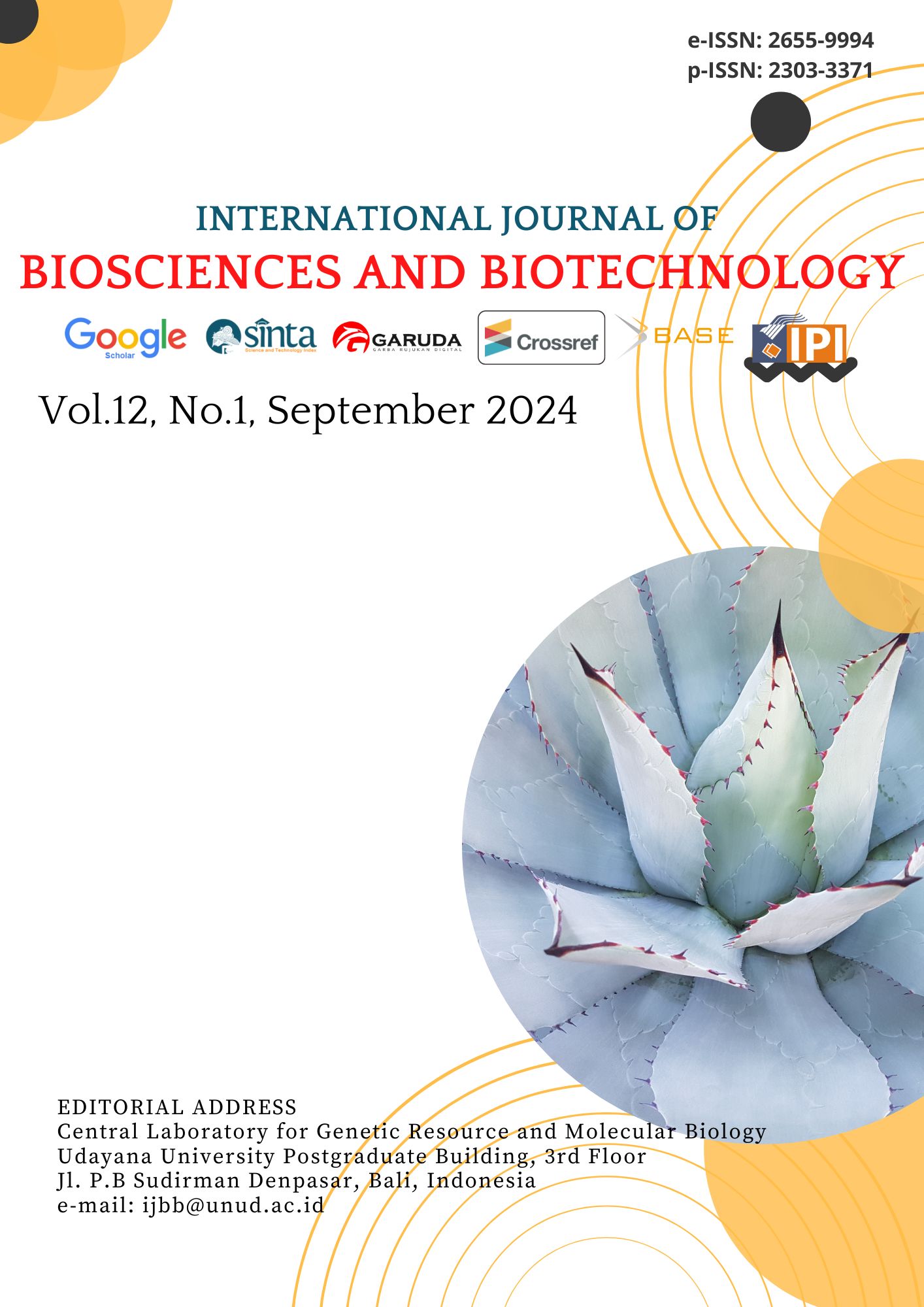Antioxidant and Inhibition of Essential Oil of Siam Citrus Peel (Citrus Nobilis L.) Kintamani Test Against Candida albicans hat Caused Candidiasis Fungal Infection
Abstract
Siam citrus (Citrus nobilis L.) is one of the annual fruit crops found across Indonesia. Kintamani siam citruses are common in the Kintamani sub-district due to their high productivity and easy cultivation. However, it thas been discovered that siam citrus peel contains several benefits such as antioxidants and antifungals. Antioxidants can preserve food quality as well as health and beauty by inhibiting oxidation reactions such as binding free radicals and highly reactive molecules, thereby preventing cell damage. Candidiasis is an infection that affects several body tissues such as in oral cavity, skin, and can also attack the vagina. Candida albicans is the fungus that causes candidiasis. This study aimed to determine the ability of siam citrus peel essential oil activity at reducing free radicals and the growth of Candida albicans. Hydro steam distillation was used to extract the essential oil of the citrus. The components of the compounds contained in the essential oil of siam citrus peel were identified using Gas Chromatography-Mass Spectrophotometry, the antioxidant activity of essential oil in reducing free radicals was tested using the DPPH 0.1 mM or 40 ppm method, and the inhibition of siam citrus peel essential oil was tested by agar well diffusion method. The results showed very low antioxidant activity with an IC50 in the amount of 55475.63 ppm. However, essential oil of siam citrus peel showed very strong inhibition against C. albicans at a concentration of 1% providing an inhibitory diameter of 21 mm in agar medium.
Downloads
References
Armando, R. (2009). Producing 15 Quality Essential Oils. Bogor: Penebar Swadaya.
Asma Baiq, H. S. (2022). SARS-CoV-2 inhibitors from Nigella Sativa. Applied Biochemistry and Biotechnology, 194: 1051-1090.
Balitbangtan. (2007). Development and distribution of citrus crops in Indonesia. East Java: Innovative Technology.
Berman J, S. P. (2012). Candida albicans: A molecular resolution built on lessons from budding yeast. [Cited 2012 Jan 21], Available online at: http://www.nature.com/nrg/journal/v3/n12/box/nrg948_BX1.html.
Bouchassane, N., & Merad-Boussalah, N. (2021). Anti-Inflammatory, Antimicrobial and Insecticidal Properties of Daucus Gracilis Steinh Flowers Essential Oil. Antiinflam Antiallergy Agent Med Chem, 20(3): 264-270.
Chee HY, K. H. (2009). Antifungal Activity of Limonene against Tricophytonrubrum. J Microbiol, 37 (3): 243-246.
Fatma. Yasmin. Mahdani, D. A. (2020). Effectiveness of Citrus Limon Peel Essential Oil On Candida albicans: In Vitro Study. Biochem. Cell. Arch, 20 (1): 2957-2961.
Fessenden, R. J., & Fessenden, J. S. (2017). Organic Chemistry Volume I 3rd Edition. Jakarta: Erlangga.
Guanther, E. (1990). Essential Oils Volume I and IV A. Jakarta: Translator: University of Indonesia Press.
Hawley-Lewis RJ., H. (2007). Hawley's Condensed Chemical Dictionary 15 th. New York: John Wiley & Sons.
Wibawa, IPAH. V. S. (2019). A study of essential oil from an invasive Piper aduncum. Jurnal Biologi Udayana, 23 (2): 50-58.
Wibawa, IPAH. S. V. (2019). STUDY OF THE POTENTIAL OF OXYRIENTAL OIL OF Boenninghausenia albiflora (Hook.) Rchb. ex Meisn. IN EKA KARYA BOTANICAL GARDEN, BALI. Botanical Garden Bulletin, ISSN: 2460-1519. Vol. 22 (2): 73-82.
Juanda, D. B. (2017). total phenol content and antioxidant activity of fruit juice of five citrus species (Citrus sp.). Galenika Pharmacy Journal. 02(01): 37.
KEMENTAN. (2021). Siam citrus. In A. N. Kurniawan Budiarto, Innovative Technology of Healthy Citrus of the Archipelago (pp. 33-36). Bogor: PT Penerbit IPB Press.
Lee, R. X., & Reed, E. (2012). β-elemene effectively suppresses the growth and survival of both platinum-sensitive and resistant ovarian tumor cells. Anticancer, 32 (8): 3103-13.
Maharani, S. (2012). Effect of Siwak (Salvadora persica) Extract Solution at Various Concentrations on the Growth of Candida albicans. Yogyakarta: Faculty of Medicine, Diponegoro University.
Merck Index-O'Neil MJ, H. P. (2013). he Merck Index, An Encyclopedia of Chemicals, Drugs, and Biologicals, 15th. Cambridge: Uk: The Royal Society of Chemistry.
Nopiyanti, H., Agustirani, F., & Isnaini, M. (2016). Screening of Nypa Fructions as Antibacterial of Bacillus subtilis E. Coli and S. aureus. Journal Maspori, 8 (2) : 83-90.
Prabajati R, H. I. (2017). Effects of citrus limon essential oil (Citrus. Dental Journa, 50(1): 43-48.
Prianto, H. R. (2013). Isolation and Characterization of clove flower oil. Chemistry Student Journal, 269-275
PubChem. (2004). D-Limonene. PubChem. National Library of Medicine, Available online at: https://pubchem.ncbi.nlm.nih.gov/compound/440917#section=Uses.
PubChem. (2004). Limonene. PubChem. National Library of Medicine, Available online at: https://pubchem.ncbi.nlm.nih.gov/compound/22311#section=Uses.
PubChem. (2004). octan-1-ol. PubChem. National Library of Medicine, Available online at: https://pubchem.ncbi.nlm.nih.gov/compound/957#section=Uses.
PubChem. (2005). Linalyl formate. PubChem. National Library of Medicine, Available online at: https://pubchem.ncbi.nlm.nih.gov/compound/61040.
Rana, O. C., & Ayu Mashartini Prihanti. (2021). Inhibition of Essential Oil Extract of Siam Citrus Peel (Citrusnobilis L.) against the Growth of Candida albicans. e-Journal of Health Library, vol. 9 (3) : 166-170.
Sagel, R. K. (1993). Guidelines for Concrete Work. Jakarta: Erlangga.
Samatha, T. S. (2012). Quantification of Total Phenolic and Total Flavonoid Contentsin Extracts of Oroxylum indicum L.,Kurz. Asian Journal of Pharmaceutical and Clinical Research,, 5 : 178-180.
Setiati, S. d. (2014). Handbook of Internal Medicine. 2nd Edition. Jakarta Pusat: InternaPublising.
The Chemical and Products Database. (2018). a resource for exposure-relevant data on chemicals in consumer products. Scientific Data volume 5, p. 180125.
Voigt, R. (1994). Textbook of Pharmaceutical Technology V. Yogyakarta: UGM Press.
Warsudi, E. (2022). Forecast of the 2022 Dry Season in Indonesia. Available online at: https://www.bmkg.go.id/berita/?p=prakiraan-musim-kemarau-tahun-2022-di-indonesia&lang=ID&s=detil.
Yanuar, W. (2002). Antioxidant and Immunodulatory Activities of non-rice cereals. Malang: University of Muhammadiyah Malang.






